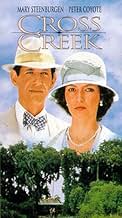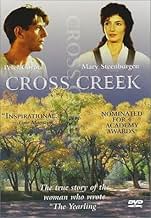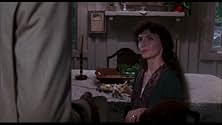In the 1930s, Marjorie Kinnan Rawlings moves to Florida's backwaters to write in peace. She feels bothered by affectionate men, editor and confused neighbors, but soon she connects and write... Read allIn the 1930s, Marjorie Kinnan Rawlings moves to Florida's backwaters to write in peace. She feels bothered by affectionate men, editor and confused neighbors, but soon she connects and writes The Yearling, a classic of American literature.In the 1930s, Marjorie Kinnan Rawlings moves to Florida's backwaters to write in peace. She feels bothered by affectionate men, editor and confused neighbors, but soon she connects and writes The Yearling, a classic of American literature.
- Director
- Writers
- Stars
- Nominated for 4 Oscars
- 2 wins & 7 nominations total
- Director
- Writers
- All cast & crew
- Production, box office & more at IMDbPro
Featured reviews
"Cross Creek" (1983) is a historical drama about the famous author of "The Yearling"; it's also part wilderness drama. Shot on location in gorgeous Alachua & Marion Counties, the film's worth watching just for the remote Floridian lushness. The theme is to die for as Marjorie DECIDES what she wants to do and then boldly (or stubbornly) DOES IT, come what may. Her first two short stories were published in 1931 and "The Yearling" in 1938, which won a Pulitzer Prize for fiction and was made into a movie in 1946.
The boggy locations are similar to those in "Frogs" (1972) and "Swamp Thing" (1982) while the topic and themes are reminiscent of "The Whole Wide World" (1996) and "Sounder" (1972). If you favor the latter two movies and appreciate the locations of the former two, you'll enjoy "Cross Creek."
The movie runs 2 hours, 7 minutes.
GRADE: B/B+
She left behind a husband who was unwilling to relocate, and fashioned a working studio in the most rural of southern locations.
The trials she experienced, both creatively and physically, are depicted in this slow-moving, yet well-intentioned enactment.
Filmed in lovely Technicolor in Marion and Alachna Counties, Florida by John Alonzo, to the accompaniment of a lush score by Leonard Roseman, the movie attempts to capture Rawling's varied experiences in pursuit of her writing goals.
Like many films of true-to-life creative artists, one has little factual evidence as to the accuracy of this tale. The challenges Rawlings faced in attempting to first write her "Gothic novel" and getting rejected by a publisher, are carefully acted out.
Only when she changes her subject to that which she is actually experiencing there in Florida does her publisher accept the manuscript.
Since there's not much dramatic about a writer "pecking away" at a typewriter, the script finds other things to depict. When a local girl has an emotional "turn" involving a pet deer, and when the focus is on our heroine's saving her farm crops from devastation, another plot begins to be recalled.
One realizes this is the story of the woman who finally wrote the beloved family classic, "The Yearling."
The film version of that novel, after a failed attempt in the early forties with Spencer Tracy, was finally brought to the screen in 1946 by Director Clarence Brown, with Gregory Peck. That movie captures the essence of Rawlings' work, again in a beautiful Florida setting.
"Cross Creek" may perhaps appear to lack focus or be too deliberately paced for some tastes. At the same time, it has its heart in the right place in expressing Rawlings' unusual "artist retreat," as well as her steadfast dedication to her craft.
For those who think writing is easy, this may be a stark awakening as to the tenacity it often takes to birth a respectable literary work.
As played beautifully by Mary Steenburgen, we meet Rawlings during the Twenties as a woman with a passion to go to the land and a burning desire to write. She's been submitting potboiler romance novels to publishers who keep telling her to reach for her soul in her writings.
Steenburgen divorces her husband and moves to some Florida swamp land which she by dint of her own hard work and the help of neighbors, she turns into a decent patch for an orange grove. One of them, storekeeper Peter Coyote, evinces more than a neighborly interest.
It's her letters from her town of Cross Creek that excite Steenburgen's potential publisher, Malcolm McDowell, the simple lives and dignity of her neighbors with all their flaws. Especially neighbor Rip Torn and his family, they become the models for the characters in The Yearling.
Cross Creek earned Academy Award nominations for Rip Torn as Best Supporting Actor and Alfre Woodard playing a black woman who Steenburgen takes in and works for her. Cross Creek also got nominations for Best Music Score and Costume Design. Why Mary Steenburgen wasn't nominated for Best Actress is a mystery.
One really ought to see Cross Creek back to back with The Sun Comes Up which was Rawlings original work for the screen and was Jeanette MacDonald's last film. Seeing Cross Creek puts a lot of The Sun Comes Up in context with MacDonald's character and with how Rawlings is interpreted by Steenburgen. Both films will take on a new dimension if anyone has not seen the other.
Cross Creek is one excellent piece of film making about the genesis of a great American writer.
The visuals are beautiful, mostly shot on location in Cross Creek. It certainly evokes this part of Florida. (I grew up about 25 miles from the setting.) Some negatives lower my rating. But despite these, I still highly recommend the film.
Though many like the score, I found it mostly sappy, the only exceptions being the music created by the characters.
Summer never seems to come. Once we see MKR wipe her brow. We get no sense of the oppression of the summer heat and humidity.
But likewise, winter never seems to come. For goodness sake, when you're lighting fires to protect orange trees, that's because it's FREEZING! Those orange trees won't be hurt above about 25F. And freezing weather in Florida is normally accompanied by wind. This may not seem like much to those who live farther north, but it requires more serious clothing than most of the characters don. Yet none seem to notice that it's cold. And MKR's house wouldn't have been so well heated that she could sleep in that weather with only light clothes and covers.
It never gets muddy. The movie shows some torrential downpours, yet when the characters get back out on the roads and paths, it's all dry and neat. That doesn't happen in the swamp.
And it never seems to get buggy. We hear a couple of mentions of mosquitoes but mostly they don't seem like a big problem. People just sit and walk around with no sign that they notice.
Did you know
- TriviaNorton Baskin, portrayed in the movie by Peter Coyote and the real life second husband of the source novelist and film subject Marjorie Kinnan Rawlings, has a small role in the movie as the man in a rocking chair giving directions to Marjorie to the hotel. Baskin also acted as a consultant to the picture.
- Quotes
[last lines]
Marjorie Kinnan Rawlings: [voiceover] I had become a part of Cross Creek. I was more than a writer. I was a wife, a friend, a part of the earth. Who owns Cross Creek? The earth may be borrowed, not bought, may be used, not owned. It gives itself in response to love and tenderness, offers its seasonal flowering and fruiting. Cross Creek belongs to the wind and the rain, to the sun and seasons, to the cosmic secrecy of seed, and beyond all, to time.
- ConnectionsFeatured in The Oscars (2020)
- How long is Cross Creek?Powered by Alexa
Details
Box office
- Gross US & Canada
- $200,000
Contribute to this page


































